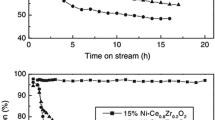Abstract
Mathematical models for both bench- and pilot-scale methanol synthesis reactors were developed by estimating the overall heat transfer coefficients due to different heat transfer characteristics, while the effectiveness factor was fixed because the same catalysts were used in both reactors. The overall heat transfer coefficient of a pilot-scale reactor was approximately twice that of a bench-scale reactor, while the estimate from the correlation reported for the heat transfer coefficient was 1.8-times higher, indicating that the values determined in the present study are effective. The model showed that the maximum methanol production rate of approximately 16 tons per day was achievable with peak temperature maintained below 250 °C in the open-loop case. Meanwhile, when the recycle was used to prevent the loss of unreacted gas, peak temperature and production rate decreased due to low CO and CO2 fraction in the recycled stream at the same space velocity as the open-loop operation. Further analysis showed that, since the reaction was in the kinetic regime, the production rate could be maximized up to 18.7 tons per day by increasing the feed flowrate and inlet temperature despite thermodynamically exothermic reaction.
Similar content being viewed by others
References
G. A. Olah, Angew. Chem. Int. Ed., 44, 2636 (2005).
G. A. Olah and G. K. S. Prakash, US Patent (US7608743 B2) (2009).
B. Denise, R. P. A. Sneeden and C. Hamon, J. Mol. Catal., 17, 359 (1982).
P. Mizsey, E. Newson, T. B. Truong and P. Hottinger, Appl. Catal. A: Gen., 213, 233 (2001).
M. Sedighi, M. Ghasemi and A. Jahangiri, Korean J. Chem. Eng., 34, 997 (2017).
H. W. Lim, M. J. Park, S. H. Kang, H. J. Chae, J. W. Bae and K. W. Jun, Ind. Eng. Chem. Res., 48, 10448 (2009).
J. Toyir, P. R. r. de la Piscina, J. L. G. Fierro and N. s. Homs, Appl. Catal. B: Environ., 29, 207 (2001).
J. Wu, S. Luo, J. Toyir, M. Saito, M. Takeuchi and T. Watanabe, Catal. Today, 45, 215 (1998).
K. Klier, Adv. Catal., 31, 243 (1982).
G. Natta, in Catalysis, P. H. Emmett Eds., Reinhold, New York (1955).
M. Takagawa and M. Ohsugi, J. Catal., 107, 161 (1987).
M. Peter, M. B. Fichtl, H. Ruland, S. Kaluza, M. Muhler and O. Hinrichsen, Chem. Eng. J., 203, 480 (2012).
N. Park, M. J. Park, Y. J. Lee, K. S. Ha and K.W. Jun, Fuel Process. Technol., 125, 139 (2014).
D. Kopač, M. Huš, M. Ogrizek and B. Likozar, J. Phys. Chem. C, 121, 17941 (2017).
I. Løvik, M. Hillestad and T. Hertzberg, Comput. Chem. Eng., 22, S707 (1998).
H. Kordabadi and A. Jahanmiri, Chem. Eng. J., 108, 249 (2005).
H. Kordabadi and A. Jahanmiri, Chem. Eng. Process., 46, 1299 (2007).
H. W. Lim, H. J. Jun, M. J. Park, H. S. Kim, J. W. Bae, K. S. Ha, H. J. Chae and K. W. Jun, Korean J. Chem. Eng., 27, 1760 (2010).
C. Zhang, K.-W. Jun, R. Gao, G. Kwak and H.-G. Park, Fuel, 190, 303 (2017).
J. M. Smith, H. C. Van Ness and M. M. Abbott, Introduction to Chemical Engineering Thermodynamics, 7th Ed. McGraw-Hill, New York (2005).
H. S. Fogler, Elements of Chemical Reaction Engineering, Prentice-Hall, New Jersey (1999).
E. N. Sieder and G. E. Tate, Ind. Eng. Chem., 28, 1429 (1936).
G. H. Graaf, P. J. J. M. Sijtsema, E. J. Stamhuis and G. E. H. Joosten, Chem. Eng. Sci., 41, 2883 (1986).
K. L. Ng, D. Chadwick and B. A. Toseland, Chem. Eng. Sci., 54, 3587 (1999).
Author information
Authors and Affiliations
Corresponding author
Rights and permissions
About this article
Cite this article
Son, M., Park, MJ., Kwak, G. et al. Maximum production of methanol in a pilot-scale process. Korean J. Chem. Eng. 35, 355–363 (2018). https://doi.org/10.1007/s11814-017-0295-7
Received:
Accepted:
Published:
Issue Date:
DOI: https://doi.org/10.1007/s11814-017-0295-7



